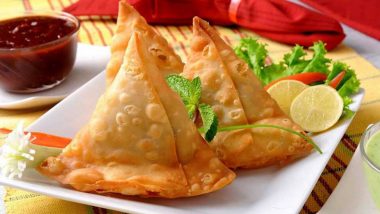A Samosa is such a blessing for those who absolutely love street food. The triangular shaped fried snack served hot with green chutney can always get your mouth watering. Samosa has a good spicy potato filling inside and the crisp on the outside, make it so relishing. Rare are those who would outright deny a samosa offer. It may be junk, people may talk about its fattening and unhealthy measures but then the taste precedes over the negatives.
You will find a samosa vendor in almost every galli in the city. Our love affair with samosa begins when we have it offered on our paper plates at birthday parties to when we can afford to buy our own samosas for the family on our way back home. Because again, there’s no saying any to samosa! Most of us tend to finish up the filling part and keep the crunchy sides to relish at the end. The feeling of munching on the crunchy, sometimes burnt sides is so delightful.
History and Origin of Samosa
We can fall short of words to express the fulfilment offered by this small snack item. But as we look into our fascination with it, let us understand the origins of the delectable crunch munch! It may disappoint you to know that it is not of Indian origin. The roots of samosa are in the Middle East somewhere in the 10th century.
They find a mention in Iranian historian’s work calling it a ‘sambosa.’ They were used as a travel snack, as they were easy to carry and could be eaten on the go. Arab cookbooks have a reference as ‘sanbusak’ in the 10th and 13th centuries. The South Asian countries were introduced to it through the Delhi Sultanate when the cooks came to work in Middle Eastern Asia for the royalty. In those days, they had meat fillings inside to suit the royal demands. In fact, the samosa has seen the royal to local transition and now settled into a snack preferred by people irrespective of their class or status. The royal kitchens saw the extravagance of the snack, but it has found its foot as a recognized street snack in the country today.
Types of Samosas in India

Samosa traveled its course from Egypt to Central Asia to India and now far and wide. Even within India as the areas develop, the preparations vary. Uttar Pradesh adopted the vegetarian fillings of potato mash and years later it is being experimented with. Non-veg fillings still are very popular in North India. The fillings, the chutney, the servings vary from state to state but the expected crunch and need to have samosa stays! In South India they include more other vegetables, the chutneys vary. In Hyderabad, it is called lukhmi, filled with mince-meat. In Bengal, they are a sweeter and smaller version. Gujiya samosa is relished as a festive item.
Today samosa has not restricted itself to India alone, but abroad it is known as a popular Indian snack. Why not? From samosa, we have an assortment of other dishes too. There is samosa chat, samosa sandwich, chole samosa and so on. The sour and sweet tamarind chutney, spicy green or dry red chutney, it creates a flavour we constantly.
The popularity of Samosa Abroad
It remains a popular snack in the Middle East, which has feta cheese, onions, minced chicken fillings. The Goan variety made with minced pork, chicken, or beef spread to Portugal, Mozambique, and Brazil, where it is known as ‘pastéis’. Central-Asian Turkic speaking countries have baked samosas. In Ethiopia and Somalia it is a traditional dish served on special occasions- Ramadan to Christmas! The healthier varieties are tried in the west. Even ready-to-eat varieties are made available, so we know how the cravings are catered to! Did you know there is a National Samosa Week happening in UK?
Samosa has globalized and has become a snack enjoyed by people everywhere. A royal treat took its humble road and continues to serve the world with its deliciousness. In the truest sense, Samosa has our hearts!
(The above story first appeared on LatestLY on Sep 05, 2018 04:11 AM IST. For more news and updates on politics, world, sports, entertainment and lifestyle, log on to our website latestly.com).













 Quickly
Quickly


